How Do I Learn To Draw
Tracing has a real bad name in the creative community, and for a good reason—an artist can spend years to acquire how to describe a realistic human from imagination, and a tracer can replicate the aforementioned end result in minutes.
However, there are other forms of tracing that take nothing to do with pretending you lot accept creative skills. On the reverse—these forms help you get the skills! Amateur tracers copy the terminal lines of the object, only to draw these final lines without a reference, y'all need to know where they come from. And drawing direct over the photo will aid you discover it.
In this brusque tutorial I'll show you what topics y'all can study with this technique to become improve at drawing from imagination, as well how to written report to get the best results.
What You Tin can Study by Tracing
Gesture
Proportions and beefcake are all important, just if you start the image with them in listen, you're likely to end up with a potent, unnatural pose. That's why it's better to starting time with a gesture sketch—a couple of dynamic lines encapsulating the "rhythm" of the pose.
So that's the general advice, but I always establish it difficult to put it into practice. This is where tracing comes to assistance: you tin sketch the lines over the torso, experimenting with various sets of lines and testing which method encapsulates the motility best. Afterward this practise you'll offset to see these lines in your references even without sketching them!
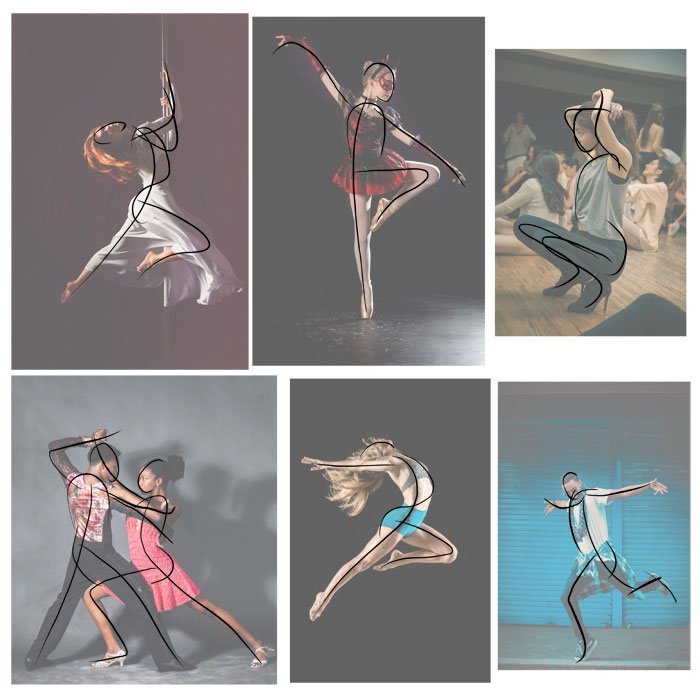
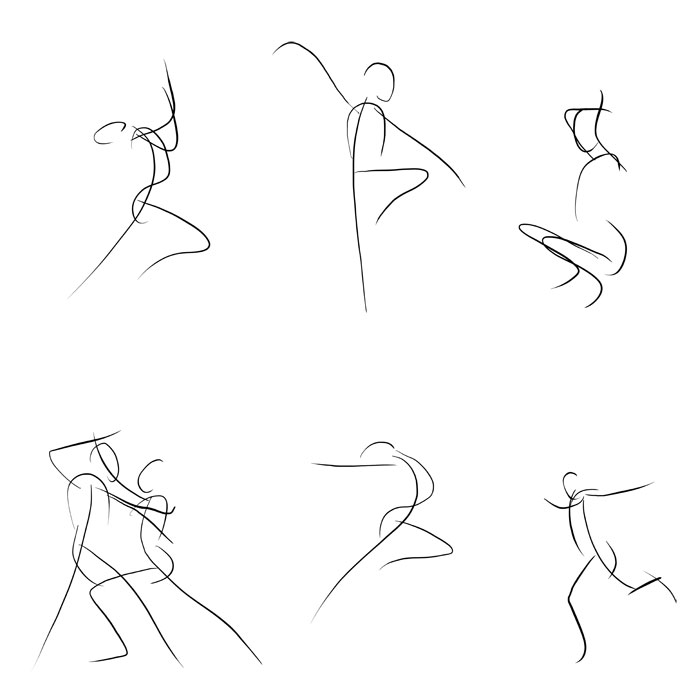
Structure
Once y'all take the gesture sketch, you lot tin add construction to it—sketch the trunk parts. Every creature has its own body plan, and one time y'all learn it, y'all'll be able to depict it from imagination—too as design believable creatures by combining various structures into something new.
Tracing allows yous to analyze the construction and experiment with various means of picturing it. For me the structure looks like a simplified skeleton, but yous may observe something else works better for you. Exercise on different poses to make certain your "recipe" is universal and takes everything into account.
In one case you accept the full general recipe, you lot tin can likewise turn this practice into the pose study. Learn about the motion of your subjects, well-nigh the limits of its joints, how it walks, jumps, and rests. This will add up to your visual library and will help y'all describe more convincing creatures from imagination.
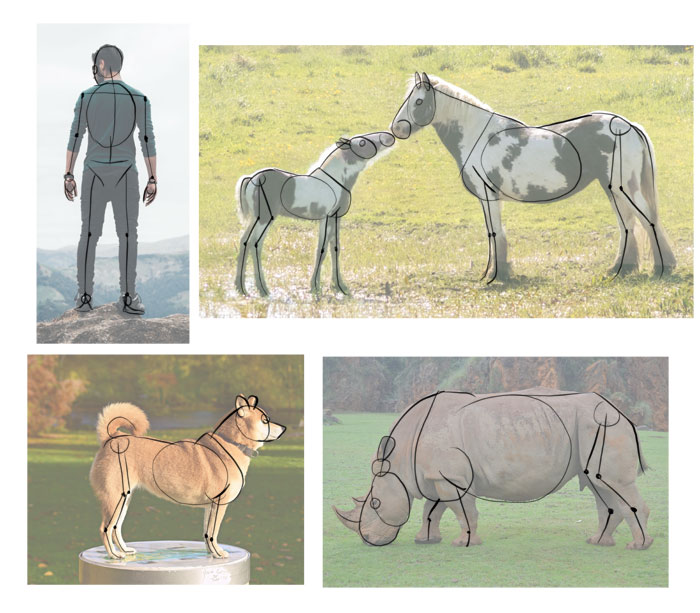
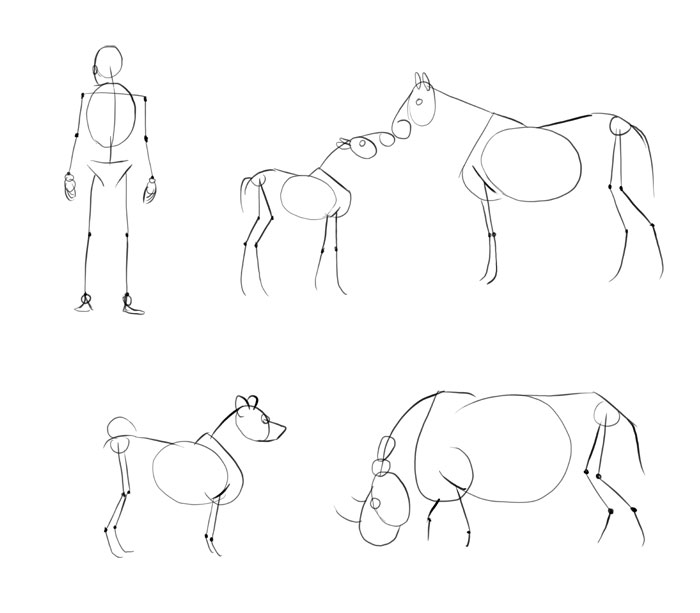
Proportions
A good cartoon must be proportional—even if you draw cartoons, there are certain proportions that must be followed. Your eyes recognize fifty-fifty the slightest mistakes in this matter, and so when studying structure, written report the proportions as well. Endeavour to come across the relation betwixt various dimensions of the object, and memorize it every bit equal, slightly bigger/smaller, or as a sure fraction.
When studying proportions, make sure to use the second view—side, front/back, superlative/bottom. Foreshortening in 3D views volition arrive hard to compare the dimensions accurately. I've even created a Pinterest lath just for this purpose—whenever I discover a perfect side view for an brute, I put it there.
Think that you can use this method for both the whole torso, as well as the head or the paws alone. Later, you tin test your proportions ready in dissimilar views, to learn how foreshortening affects them.
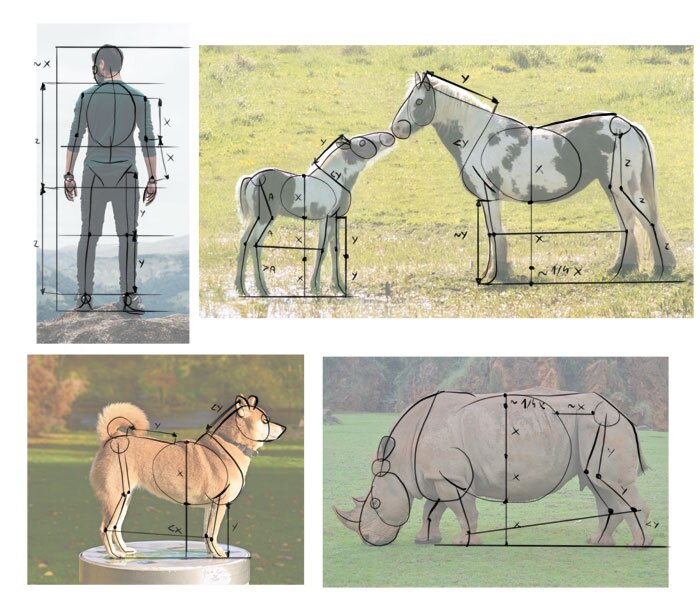
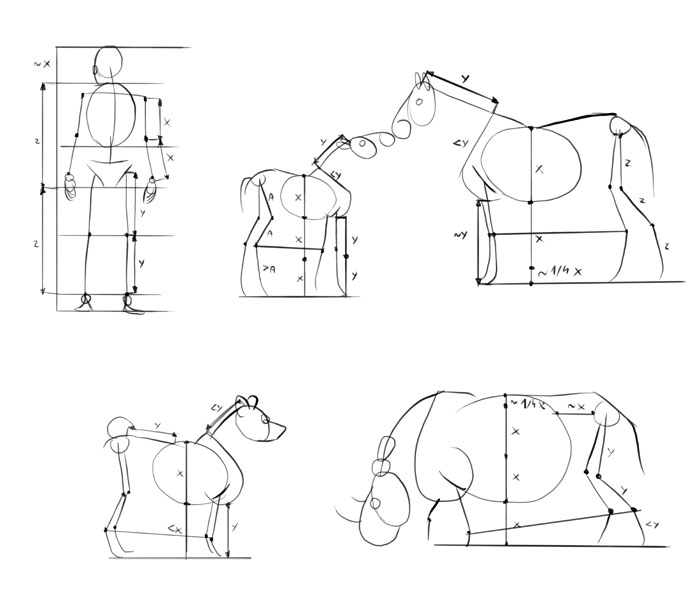
Course
Form makes the object in the drawing look 3D, but it'due south not so like shooting fish in a barrel to sympathise how to capture it. You can improve a lot at this topic past trying to draw "a wireframe" around the object. Start with unproblematic objects at beginning—peradventure ones with articulate curves, or a design suggesting their 3D form.
By studying the same object in different views, you lot can learn a lot nearly foreshortening. You don't even need to understand information technology consciously—information technology develops your intuition in this affair, making you lot better at telling when something looks off.
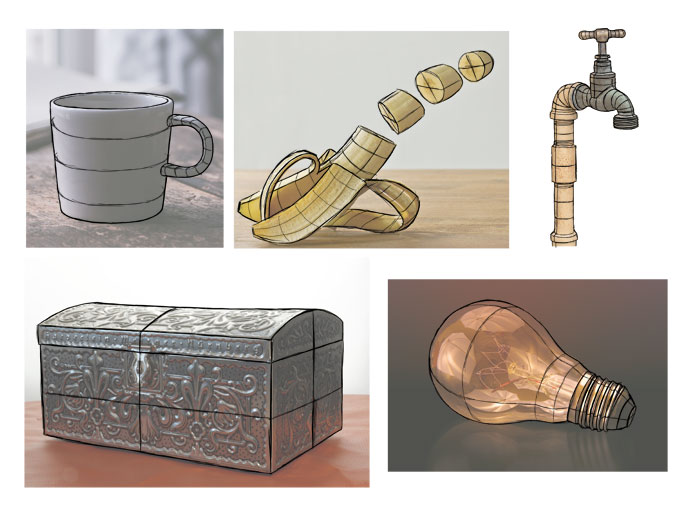
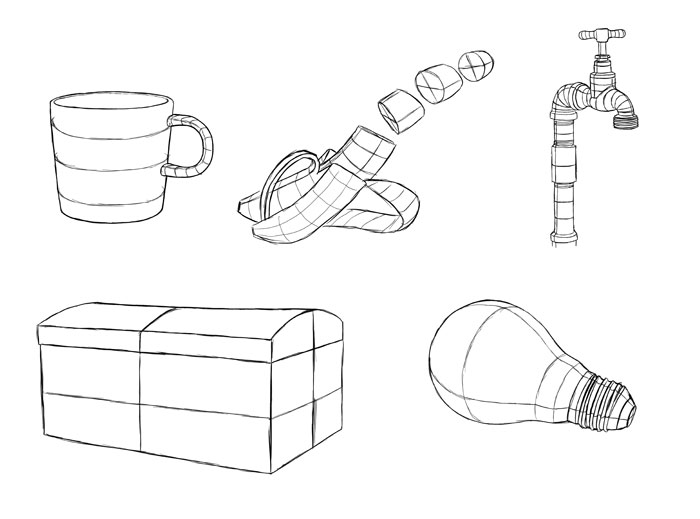
Once you lot learn how to draw the form, you can learn how to create a silhouette of a human or an animate being by simplifying their body into forms. Imagine yous want to create a wooden puppet in a shape of your subject—shave off all the unnecessary details and focus on the defining features.
Although this may await easy, it'due south difficult to practice if you have no cognition nigh the anatomy. Then it's skillful to study this topic a scrap, discover out what you lot don't know, and so become to learn more well-nigh this subject in your beefcake books.
Additionally, you can use this method to study dissimilar styles. Draw over the drawings of your favorite artists, and you lot'll see they all simplify the aforementioned body parts the same way. Once y'all learn this, you'll be able to describe in this style yourself! And if you want to create your own style, this is the good way to go—start with the original recipe, and and so modify it.
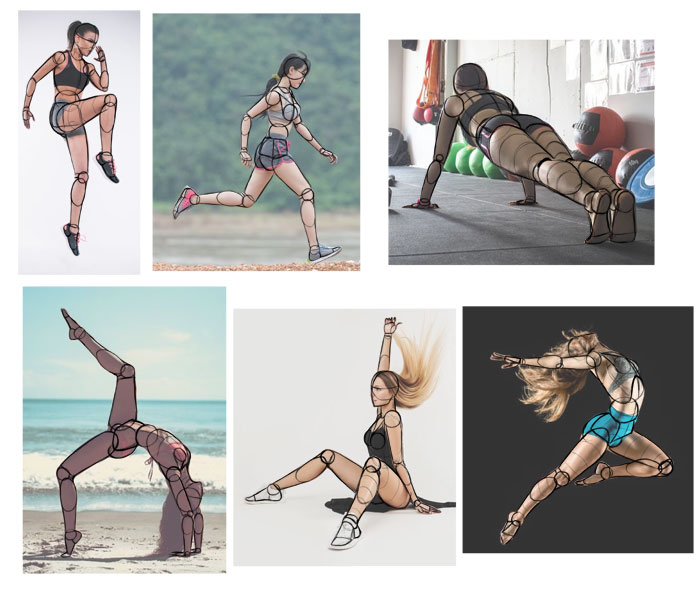
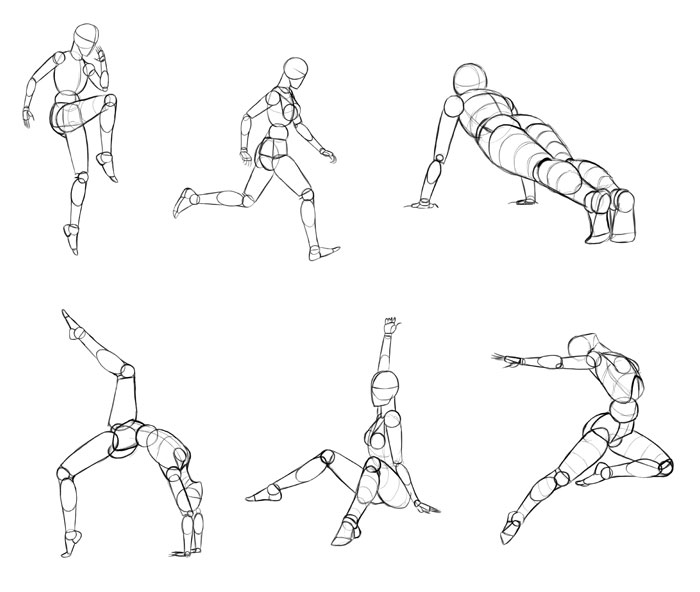
Anatomy
Yous don't have to memorize all the muscles to depict realistic creatures—you can e'er use an beefcake atlas with cool illustrations as a reference. However, these illustrations may be difficult to sympathise and apply to a creature in motion, so to be more flexible, information technology's best to study beefcake on real animals.
Find photos of muscular or skinny representatives of the species you're interested in, collect every bit many fauna beefcake resources as you can, and effort to describe the muscles/bones where they're supposed to be (co-ordinate to you anatomy diagrams). This will exist very difficult at first, but feel free to employ shortcuts—if something is hard or impossible to see, is it actually worth to learn nearly?
Likewise, don't endeavor to get information technology all perfectly at the showtime try. I've been studying fauna anatomy for years, and I still acquire something new nigh it every time I do this exercise. So information technology'due south better to just try to learn what you need for your intended style of drawing. An creative person drawing superhero comics will need a better agreement of anatomy than an artist drawing normal humans.

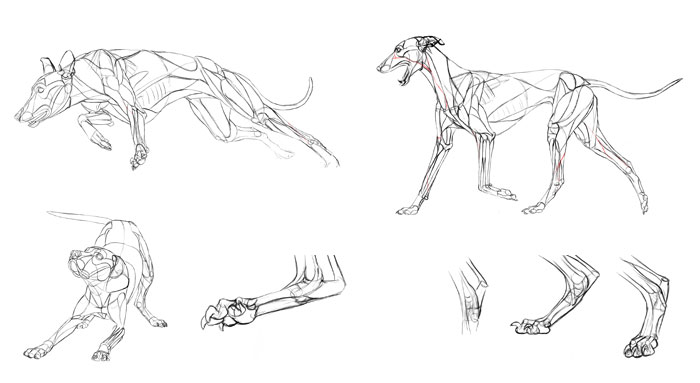
Shading/Light and Shadow
And then far we've been only talking about deconstruction. Simply what if y'all only want to draw portraits? Tracing tin can help you here likewise. Even if you merely want to copy photos, tracing the border between the light and shadow expanse can aid y'all get better equally seeing this border in the future, likewise as shade your drawing here and now.
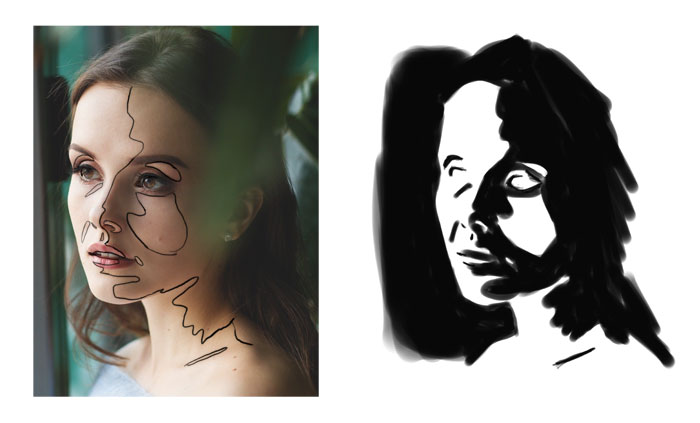
How to Written report by Tracing
Ok, so at present you know why it'due south good to study all these topics by tracing. Merely how to practise information technology, to get the best results? Here's my advice.
First, you need to detect your references. Cyberspace is full of photos, but not all of them are worth using. Google will give you plenty of smashing images for whatsoever discipline, but near of them are in modest resolution and therefore useless for this purpose. Also, about of these photos are copyrighted—you're non allowed to publish them anywhere, fifty-fifty if they're covered with the lines yous drew.
You lot're allowed to use these photos for your studies, as long as y'all don't publish the original photograph (you can publish the lines on their own). But if you desire to be completely safe, it's all-time to utilise sites with free stock images, like Pixabay or Unsplash—they provide plenty of photos in good resolution, complimentary to use, modify, and publish even without credit.
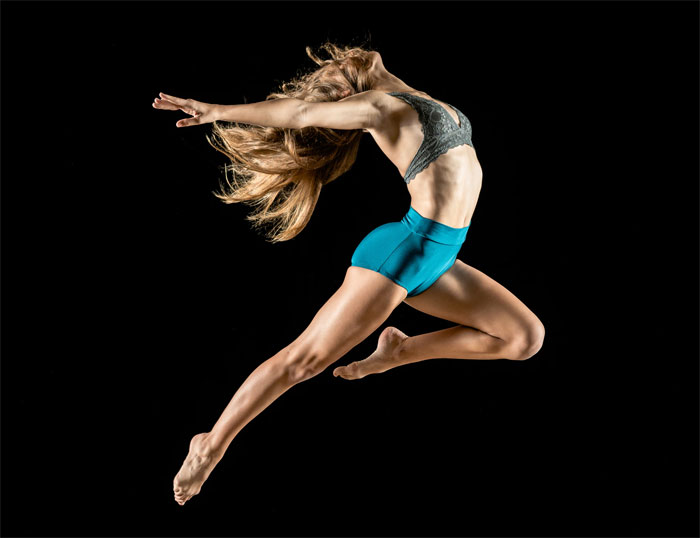
Make sure you lot choice your references carefully, with the focus on what you want to larn. Pay attention to the view, pose, clarity of the lighting. Avoid photos where the body features are covered by baggy clothes, or where of import body parts are cropped or hidden in grass. Nude models are the best for studying beefcake and form, just if they brand you experience uncomfortable, tight clothing volition exist ok, too. Don't pick photos simply because they're pretty—e'er take their usefulness in mind.
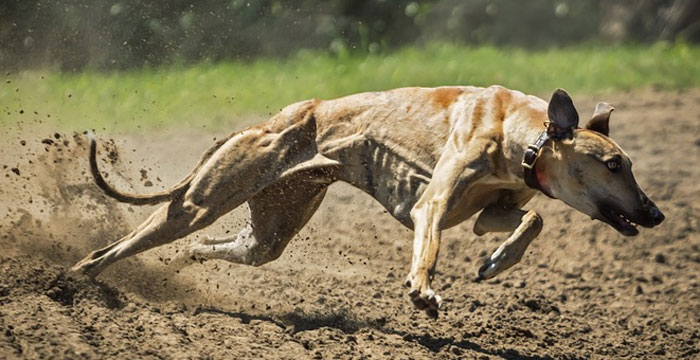

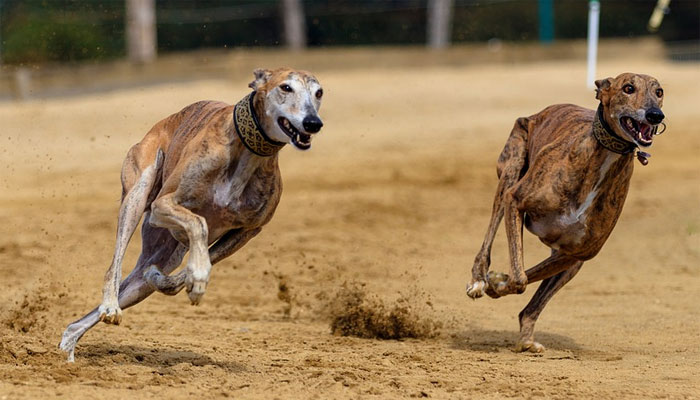
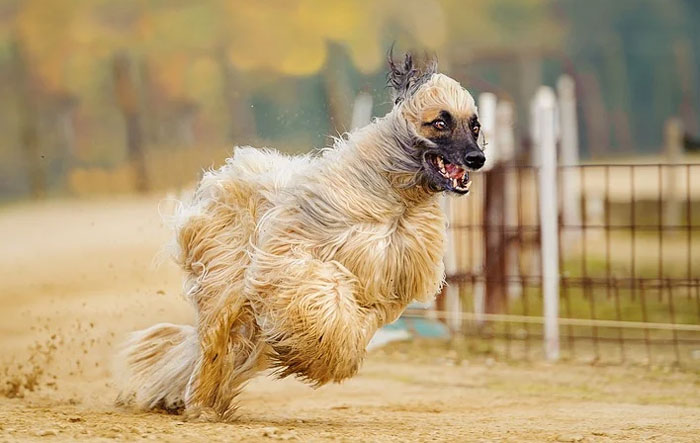
Once yous have your references, information technology'southward time to prepare them. Combine them into one big file in a photo editor—if yous want to fit more of them without making the file huge, cutting the parts of the photos that are not necessary for your study (for example, in a paw study, crop every photo to the paws).
If you have a graphics tablet, lower the opacity of this large combined photo, and start drawing. If you don't, lower the opacity besides, so print the image (plan the composition of the images to make it fit the A4 page). Draw on it using a black ink liner to make the lines clear, and try not to draw over the lines you've already fatigued—if you want to fix something, print another page and endeavor again. That's how you lot learn!
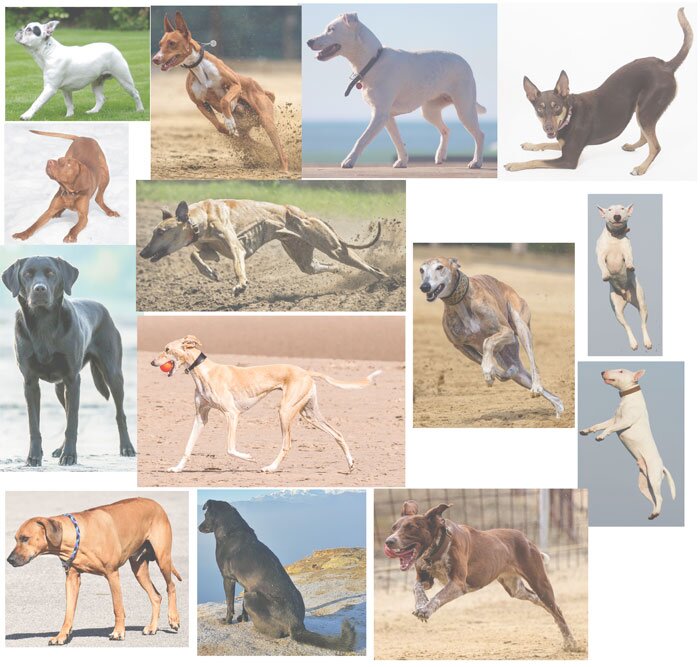
This was the technical side of the issue, let's talk more well-nigh the actual study at present. To go far the most effective, here's my proposed order:
- Draw your guessed lines on the first photo.
- Depict the aforementioned set up of lines on the other photo. Do they work? If not, try to see what the result is, and test it on another photograph. Repeat until you notice the "recipe" that works every time.
- Use the photos with the lines traced on them as a reference—re-create these lines, this time merely looking at them. You may discover that your recipe works in theory, but non in practise—come dorsum to step 2 to fix it.
- Prepare a new set up of references, with no lines traced on them. Use your recipe to copy them without tracing. If it's hard*, modify the recipe to brand it easier. You lot can come up back to step 2 to make certain you're not missing something.
- Finally, depict the recipe with no reference other than the images in your mind. Judge your results past comparing them to photos.
*Copying a reference will ever be difficult for someone who hasn't practiced proportions enough. Copying proportions is ane of the virtually bones fundamentals, then make certain y'all're good at this before yous start this study.
Go on in mind that your recipe may change with time. You may recollect yous learned everything at that place is to acquire at 1 betoken in time, but then y'all'll get new information that volition make you lot see what you've never noticed earlier. That's why information technology's good to repeat this study from fourth dimension to time, to freshen upwards your memory and to add some dash to your artistic repertoire.
But Isn't It Cheating?
Now you know how useful tracing can be, but isn't it cheating? After all, someone who never traces has to piece of work harder to learn all of this. Just… and so what? An creative person who just draws when hanging upside downwardly from the ceiling works harder, merely does it make them a improve artist?
Look at it this way: tracing can be adulterous, but it doesn't have to be. Driving a motorcar during a bike race is cheating, but it doesn't mean that driving a car to get your groceries is cheating as well. Tracing can exist a corking, useful tool to make you a better artist, and you shouldn't avoid information technology but because yous heard that information technology's bad to trace.
If you only give this method a effort, yous'll run across it has little to exercise with mindless cartoon. Y'all have to analyze and think, and spend plenty of time trying different things. And when you lot stop a study, what you lot produce is non fifty-fifty an artwork—it's merely a visual side effect of your learning.
Sometimes the finish outcome of your report may be quite educational, and so it's good to share it with others. However, ever call back to phone call information technology for it is: a study, not an artwork. Studies can wait quite impressive, just be careful not to brand it the priority—learning should ever be the focus. It's amend to draw an ugly study and larn something, than to draw something pretty without learning anything!
Source: https://monikazagrobelna.com/2020/08/16/how-to-learn-to-draw-by-tracing/
Posted by: alanizthates.blogspot.com


0 Response to "How Do I Learn To Draw"
Post a Comment